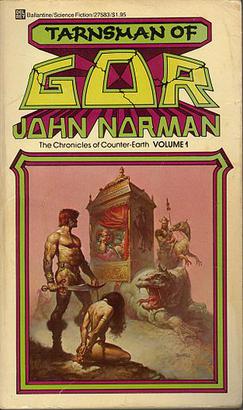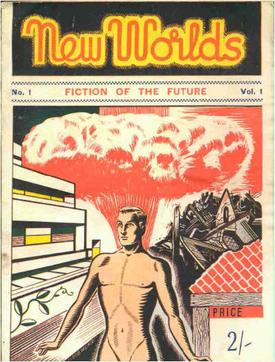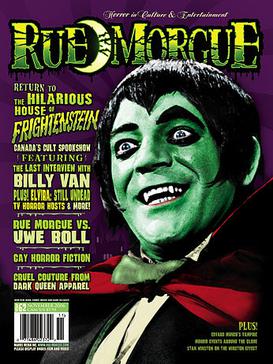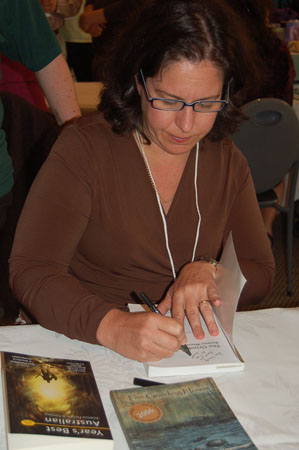
Gor is the fictional setting for a series of sword and planet novels written by philosophy professor John Lange, writing as John Norman. The setting was first described in the 1966 novel Tarnsman of Gor. The series is inspired by science fantasy pulp fiction works by Edgar Rice Burroughs, such as the Barsoom series. It also includes erotica and philosophical content. The Gor series repeatedly depicts men abducting and physically and sexually brutalizing women, who grow to enjoy their submissive state. According to The Encyclopedia of Science Fiction, Norman's "sexual philosophy" is "widely detested", but the books have inspired a Gorean subculture.

Dangerous Visions is an anthology of science fiction short stories edited by American writer Harlan Ellison and illustrated by Leo and Diane Dillon. It was published in 1967 and contained 33 stories, none of which had been previously published.

Damien Francis Broderick is an Australian science fiction and popular science writer and editor of some 74 books. His science fiction novel The Dreaming Dragons (1980) introduced the trope of the generation time machine, his The Judas Mandala (1982) contains the first appearance of the term "virtual reality" in science fiction, and his 1997 popular science book The Spike was the first to investigate the technological singularity in detail.

Asimov's Science Fiction is an American science fiction magazine edited by Sheila Williams and published by Dell Magazines, which is owned by Penny Press. It was launched as a quarterly by Davis Publications in 1977, after obtaining Isaac Asimov's consent for the use of his name. It was originally titled Isaac Asimov's Science Fiction Magazine, and was quickly successful, reaching a circulation of over 100,000 within a year, and switching to monthly publication within a couple of years. George H. Scithers, the first editor, published many new writers who went on to be successful in the genre. Scithers favored traditional stories without sex or obscenity; along with frequent humorous stories, this gave Asimov's a reputation for printing juvenile fiction, despite its success. Asimov was not part of the editorial team, but wrote editorials for the magazine.

David Rowland Langford is a British author, editor, and critic, largely active within the science fiction field. He publishes the science-fiction fanzine and newsletter Ansible and holds the all-time record for most Hugo Awards, with a total of 29 wins.

Omni was a science and science fiction magazine published for domestic American and UK markets. It contained articles on science, parapsychology, and short works of science fiction and fantasy. It was published as a print version between October 1978 and 1995. The first Omni e-magazine was published on CompuServe in 1986 and the magazine switched to a purely online presence in 1996. It ceased publication abruptly in late 1997, following the death of co-founder Kathy Keeton; activity on the magazine's website ended the following April.

Nemonymous was an experimental short fiction publication that labeled itself a "megazanthus". It was published and edited in the United Kingdom from 2001–2010 by D.F. Lewis.

New Worlds was a British science fiction magazine that began in 1936 as a fanzine called Novae Terrae. John Carnell, who became Novae Terrae's editor in 1939, renamed it New Worlds that year. He was instrumental in turning it into a professional publication in 1946 and was the first editor of the new incarnation. It became the leading UK science fiction magazine; the period to 1960 has been described by science fiction historian Mike Ashley as the magazine's "Golden Age".

Rue Morgue is a multinational magazine devoted to coverage of horror fiction. Its content comprises news, reviews, commentary, interviews, and event coverage. Its journalistic span encompasses films, books, comic books, video games, and other media in the horror genre. Rue Morgue was founded in 1997 by Rodrigo Gudiño, and is headquartered in Toronto, with regional offices in various countries throughout North America, the United Kingdom, and Europe. The magazine has expanded over time to encompass a radio station, book publishing company, and horror convention. The magazine's namesake is Edgar Allan Poe's short story "The Murders in the Rue Morgue" (1841).
Steve Berman is an American editor, novelist and short story writer. He writes in the field of queer speculative fiction.

Polymancer was a magazine covering roleplaying games and related hobbies such as miniatures, wargaming, and LARPs. The magazine was published in Canada by Polymancer Studios Inc. It was distributed across the United States, across Canada, in the UK, in Australia, and in New Zealand, as well as having hard copies archived with Archives Canada. The first issue was published in 2004 and it ran for 32 issues.

Dennis William Etchison was an American writer and editor of fantasy and horror fiction. Etchison referred to his own work as "rather dark, depressing, almost pathologically inward fiction about the individual in relation to the world". Stephen King has called Dennis Etchison "one hell of a fiction writer" and he has been called "the most original living horror writer in America".

Solaris Books is an imprint which focuses on publishing science fiction, fantasy and dark fantasy novels and anthologies. The range includes titles by both established and new authors. The range is owned by Rebellion Developments and distributed to the UK and US booktrade via local divisions of Simon & Schuster.

Albedo One was an Irish horror, fantasy and science fiction magazine founded in 1993 and published by Albedo One Productions.

Kaaron Warren is an Australian author of horror, science fiction, and fantasy short stories and novels.

Catriona (Cat) Sparks is an Australian science fiction writer, editor and publisher.

Famous Fantastic Mysteries was an American science fiction and fantasy pulp magazine published from 1939 to 1953. The editor was Mary Gnaedinger. It was launched by the Munsey Company as a way to reprint the many science fiction and fantasy stories which had appeared over the preceding decades in Munsey magazines such as Argosy. From its first issue, dated September/October 1939, Famous Fantastic Mysteries was an immediate success. Less than a year later, a companion magazine, Fantastic Novels, was launched.
Steven Paulsen is an Australian writer of science fiction, fantasy and horror fiction whose work has been published in books, magazines, journals and newspapers around the world. He is the author of the best selling children's book, The Stray Cat, which has seen publication in several foreign language editions. His short story collection, Shadows on the Wall: Weird Tales of Science Fiction, Fantasy and the Supernatural), won the 2018 Australian Shadows Award for Best Collected Work, and his short stories have appeared in anthologies such as Dreaming Down-Under, Terror Australis: Best Australian Horror, Strange Fruit, Fantastic Worlds, The Cthulhu Cycle: Thirteen Tentacles of Terror, and Cthulhu Deep Down Under: Volume 3.
Three-Lobed Burning Eye is an online magazine of speculative fiction edited by Andrew S. Fuller. First published in 1999, it features stories from the genres of horror, dark fantasy, and science fiction, as well as magical realism or slipstream. All issues are collected in an annual print anthology. It is sometimes referred to as 3LBE magazine, with the subhead, "Stories that monsters like to read."















